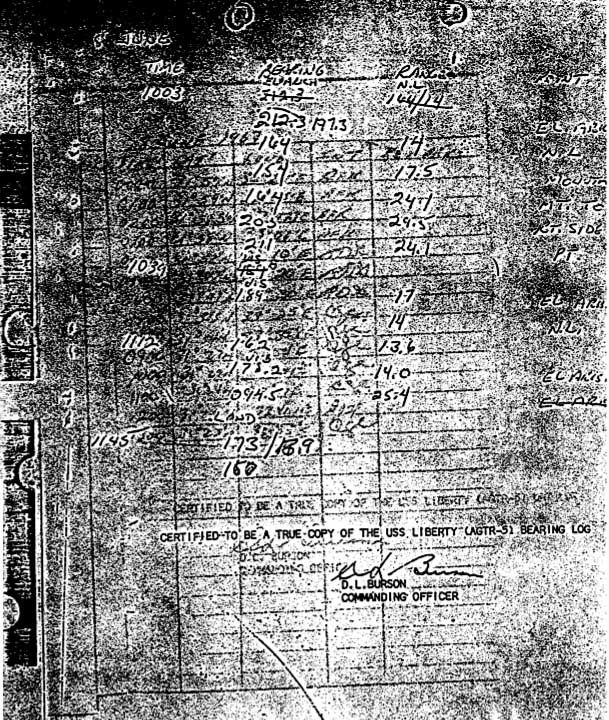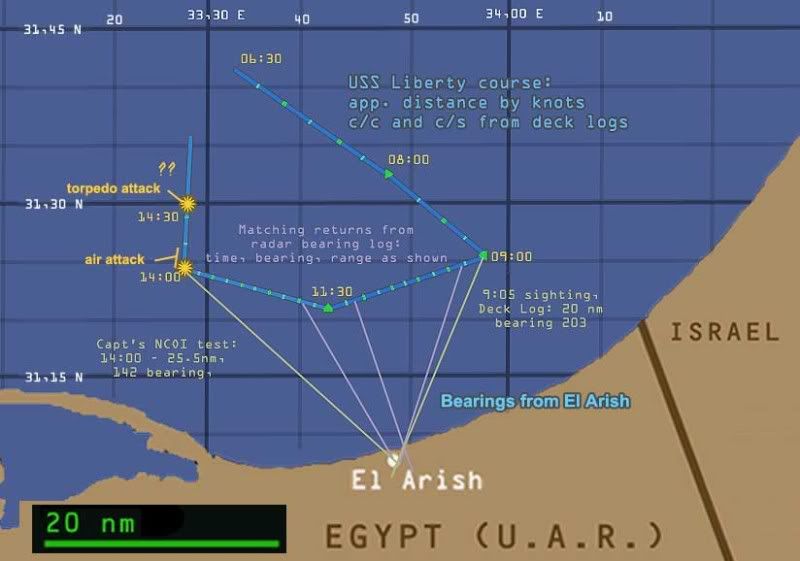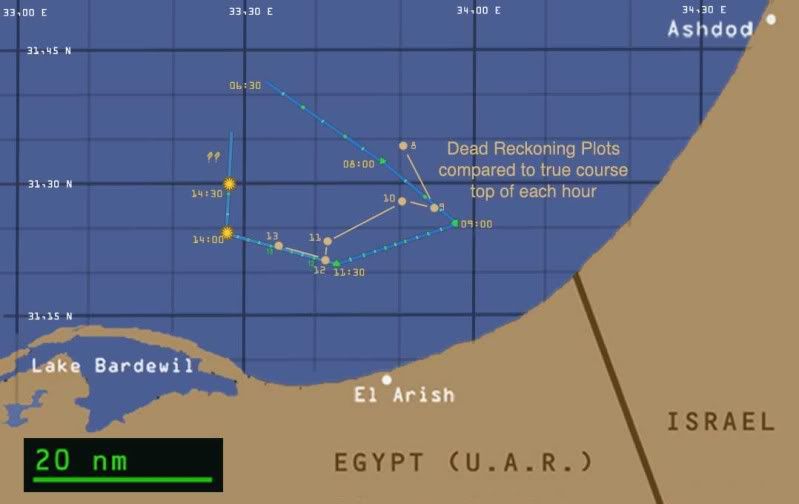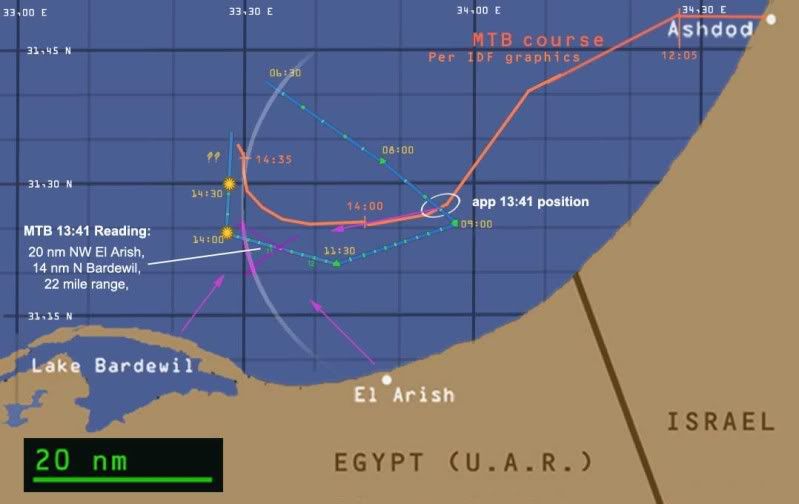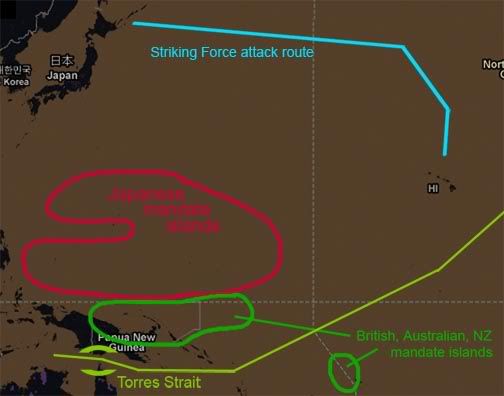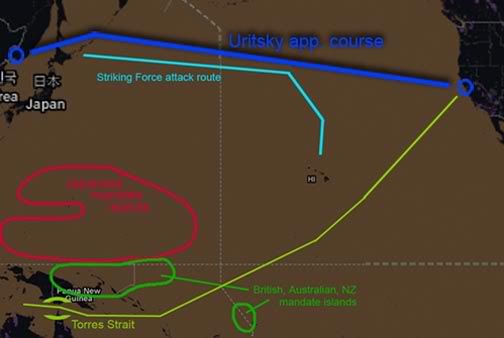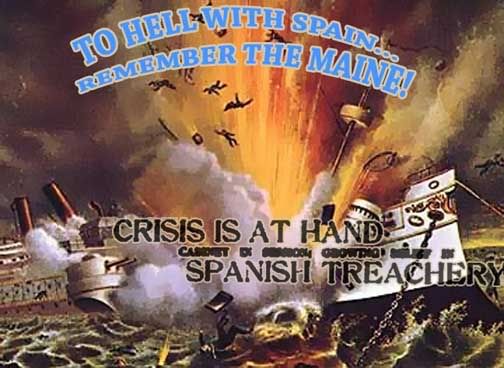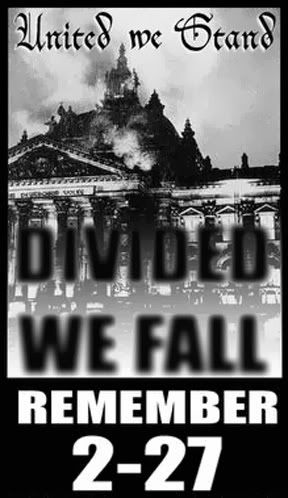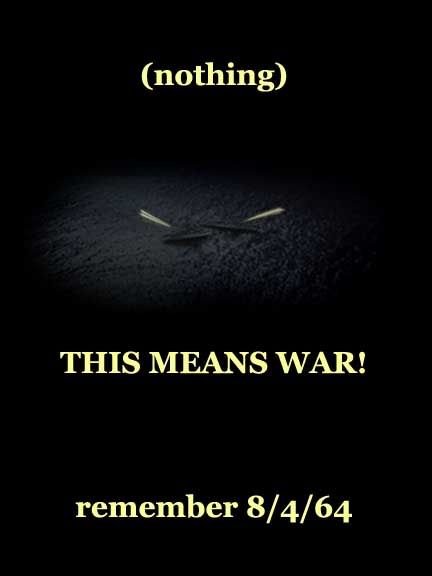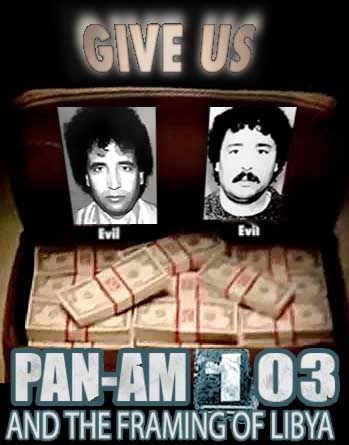Adam Larson / Caustic Logic
April 26 2009
last edit 5/2
When discussing the prolonged, coordinated IDF blitzkrieg attack on the USS Liberty, the whole “fog of war” “mistaken identity” explanation is routinely tossed out as the catch-all reason. Such people will easily suggest, essentially, that friendly fire incidents happens so often it’s a wonder anyone ever recognizes anything effectively when at war. I sense these theorists have entered their own fog once exposed to the details; the real IDF philosophy was apparently to misidentify the ship repeatedly at every turn, to start shooting immediately and keep shooting until you know who you’re shooting, and remain incredibly obtuse about figuring that out the whole way. Ain’t nothing friendly about that.
On the Liberty, in contrast, great care was taken to accurately identify the SoBs strafing and napalming her crew. Only one side in this battle seemed amazingly confused about what was going on, and the other was operating in the real world. “Fog” is more diffuse than this, bunching in spots of course, but only so densely, and drifting across lines in a natural flow. This is a proper zero-visibility “cloud front of war” - swift, heavy with storm, and driven out over the sea by some unseen wind, right ahead of the prime actors in what mechanically happened – the three motor torpedo boats (MTBs) that first tagged the Liberty for attack and very nearly sunk her.
FIRST CONTACT - BEFORE VISUAL
Designated Division 914, and code-named Pagoda, the three swift light craft were already well en route to the scene for an unspecified mission, when first alerted of their target at 13:30 [1]. It was of course framed as a suspect Egyptian warship, and shortly thereafter, at 13:41, they made first radar contact with some vessel at a range (distance) of 22 miles, almost due west of them [2]. Although what these returns told them [see below] has nothing to do with the Liberty, they were apparently what the hunters followed up to the prey.
Being the larger target, it makes sense the Liberty was seen first by the other party. She wasn’t long behind, however, and their radar operators spotted the smaller MTBs ten minutes later, at 13:51. This showed as three small surface craft, 16 nautical miles distant on a relative bearing of 82 degrees. [3] They had the correct location, number, and size of the targets, the proper bearing and range and presumably the right speed. These are the building blocks of proper identification by radar. But far from visual range, they had no ID yet nor any idea of hostility headed their way – it would be another five minutes or so before IDF jets appeared and started strafing.
Now things were a lot more foggy on the Israeli end – apparently a side-effect of being on the offensive. This is the first of several mis-identifications, as the returns were somehow interpreted as showing the craft at 28-30 knots, nearly six time the Liberty’s actual speed. They also calculated, and double-checked, a significantly different initial heading than the Liberty was on, and a change of direction shortly after being spotted, which the Liberty also did not do. These incorrect calls brought in fighter planes to catch the apparent enemy ship speeding to Egyptian Port at Said, and slow it down with repeated air attacks from 1358-1411.
FACE-TO-FACE
It wasn’t until well after these attacks that the Liberty and the MTBs were within visual range, at about 14:20. Three small fast boats appeared, fitting the radar profile with no surprise. An apparently Israeli flag, small, but enough baby blue to guess, was seen from about 2000 yards, according to the Captain. "MTB believed to be flying Star of david flag. Flag quite small." [4] During closer passes, one badge number at least was noted in the Captain’s first situation after attack report: “Hull number of one boat was 206-17.” [5]
Ensign David Lucas was the one who made this call, and when asked about this entry during the Naval Court of Inquiry, explained the number was taken down from “approximately 500 yards.” Referring to a photograph in Jane’s Fighting Ships, perhaps the same one shown here, Lucas said it “appears to be the exact same one that I identified. If I had had a camera and taken a picture of it, I would have gotten the same angle, […] what I thought to be 17, I found out later from Mr. Bennett, when I examined this book, that it was an Israeli symbol.” [6]
 In particular, it seems to be the Hebrew letter teit; the three boats of Division 914 are sometimes designated T-204, T-203, and T-206. The given length for these craft is about 93 feet, making the numbers about 2.5 feet high, and the total designation block about ten feet long, clearly visible from 500 yards. In comparison, the Liberty's overall GTR5 lettering block measured about twenty-five by ten feet, and would be visible from a much further distance.
In particular, it seems to be the Hebrew letter teit; the three boats of Division 914 are sometimes designated T-204, T-203, and T-206. The given length for these craft is about 93 feet, making the numbers about 2.5 feet high, and the total designation block about ten feet long, clearly visible from 500 yards. In comparison, the Liberty's overall GTR5 lettering block measured about twenty-five by ten feet, and would be visible from a much further distance.On their way there, the MTB crew say they felt they were racing towards an Egyptian Z-Class destroyer, based on the shelling reports, the ‘observed’ radar speed, and even initial Air Force reports in the attack. When they got to it they quickly realized that was wrong. Israeli historian Michael Oren explained how Division Commander Moshe Oen (no relation?) "could see that it could not be the destroyer that had supposedly shelled El-Arish. Rather, he believed, it was a slower-moving vessel that had either serviced that destroyer or evacuated enemy soldiers from the beach.” [7] Thus any second thoughts this gave them were quickly corrected – it was just a different Arab ship. The important but overlooked corrolary of this is the IDF’s jets had already spent twenty minutes attacking the wrong vessel and the 30-knots shore attacker was slipping away behind the distraction. This seems, from the records I've examined (all available) to have been no concern of the IDF, as they continued their attack against the easy mark in lieu of a threat they seemed to know never really existed.
The MTB crew only had access to a slim volume detailing known vessels of surrounding Arab nations, leaving them clueless about the wide world of non-Arab vessels, like the one before them. [8] Looking for the best fit therein, they Michael Oren explained:
“Consulting his naval intelligence manual, [Commander Moshe Oren] concluded that the vessel in front of him - its deck line, midship bridge and smokestack - resembled the Egyptian freighter El-Quseir. The officers of the other two boats reached the same conclusion independently, and followed Oren into battle formation.” [9 - emph mine].Simply “resembling” a possible enemy ship should never be a reason to attack; even if they were unable to gauge the Liberty’s true size and find it to be nearly twice the length and more than thrice the overall displacement of the one in their book, considering them equal in size, much did not fit. The giant middle mast must have been added along with numerous large antennae, the mid-ship structure had been built way up, the smokestack straightened and moved forward, portholes removed, and her overall shape significantly changed. [See also K.J. Halliwell's excellent analysis at the USS Liberty Inquiry site]. But otherwise, aside from the massive size difference, it definitely resembled the El Quseir. And if this was the closest fit they could find, the proper conclusion would be this was not an Arab ship at all.
 El Quseir, left and USS Liberty, not to scale. The numbers in the book and their own eyes gave them every chance to gauge the difference.
El Quseir, left and USS Liberty, not to scale. The numbers in the book and their own eyes gave them every chance to gauge the difference. LIGHTS AND BULLETS
One method of gaining more information about the ship was, quite simply, to ask them, using internationally accepted light signals. Oren related the official Israeli version of the light conversation:
“At 6,000 meters, Oren's T-204 flagship paused and signaled "AA" - "identify yourself." Due to damaged equipment, McGonagle could only reply in kind, AA, with a hand-held Aldis lamp. Oren remembered receiving a similar response from the Egyptian destroyer Ibrahim al-Awwal, captured by the Israeli navy in the 1956 war, and was sure that he now faced an enemy ship.”[10]The equipment was indeed damaged – all installed signal lights but one were shot away in the attack, by accident or design, leaving them with one tiny light six inches in diameter and nowhere near powerful enough to shine through the thick smoke roiling up from the air attack. [11] I’ve seen no evidence or reason to suspect the small light was only capable of signaling “AA.” And that's certainly not what the crew recalled sending.
Another source (Hank Roth) explained how crew member Udi Erell gave the signal as "AAA," but clearly "saw the response flickering through the smoke four miles away." [emph mine] Again the reference was made to this well-known indication of Egyptian bad-guy-ism, circa 1956. Their own identity was their best defense for the Liberty to throw out there, and in fact, the piece continues: "the Americans on the bridge of the Liberty would later state that the signals flashed were the ship's name and its international call sign, not what the Israelis believed they saw.” [12]
Oren’s article has the signaling done from 2.5 miles, Roth says four miles, and both agree that their signals were readable at that great distance, though the thick smoke, and so were the Liberty's responses. In fact, Captain McGonagle’s testimony to the Naval Court of inquiry seems to mean neither side signaled anything at this time, and common sense would indicate neither should be readable in the circumstances. First, he was asked when “the patrol boats were attempting to communicate with flashing light.”
“A. This was definitely after the torpedo attack.
Q. The flashing lights from the boats were after the torpedo attack?
A. Yes, that is correct. […] The first signaling that I observed was the unsuccessful attempts to determine what they were signaling us, and of course, we did not have a chance to answer back to them. This was after the torpedo attacks.” [13]
This implies the attackers made no attempt to communicate with the ship, which contradicts the MTB crew’s testimony. However it also goes against McGonagle’s own summary of event presented to the NCOIA Prior to the first shot, as the MTBs first sauntered up:
”When the boats reached an approximate range of 2,000 yards, the center boat of the formation was signaling to us. Also, at this range, it appeared that they were flying an Israeli flag. This was later verified. It was not possible to read the signals from the center torpedo boat because of the intermittent blocking of view by smoke and flames.” [14]This is supported by the NCOI’s chronology from the deck log, putting these signals at 14:28, and the signaling distance as 2,000 feet, much closer than the Israelis stated. [15] This development was followed by the Captain's order to the guns to hold fire, which was followed by a few rounds fired by two guns. Personally I don’t buy the crew's story of how those guns started shooting, but that’s an aside. By jittery/pissed-off sailor, captain's order misunderstood, napalm-induced anomaly, or some combination, it happened. McGonagle understood “I am sure that [the MTBs] felt that they were under fire from USS LIBERTY. At this time, they opened fire with their gun mounts and in a matter of seconds, one torpedo was noted crossing astern of the ship at about 25 yards.” [16]
The MTB Log records “detected firing flashes” at 14:35, apparently taken as a negative response to their own flashing. They then recorded the identification as El Quiser at 14:37, and their counter-attack commencing at 14:40, first torpedo launched at 14:43. [17] On the other hand, the Liberty’s logs from the deck to the boiler room show machine gun fire on both sides at 14:30/31, the first torpedo miss at 14:34, and the unambiguous deep impact at 14:35. [18] These could be troubling contradictions or could just indicate the MTBs' clocks were 5-10 minutes ahead.
Roth’s source for the initial identifying signals from Liberty were apparently later ones sent at closer range, with a more powerful light rigged up after the torpedo attack. The Chief Communications Technician, Harold J. Thompson, related this exchange as “US Naval Ship - US Naval Ship.” “do you need help.” “no, thank you.” “Do you want us to standby?” “no, thank you.” “good luck.” [19] Captain McGonagle recalled on another occasion hoisting a flag meaning that steering was erratic and they should keep away. [20] There is much here to be confused about, but it seems likely the MTBs did signal prior to the attack, but they didn’t wait for - and perhaps didn't want - an answer.
HOW SLOW THE LEARNING CURVE?
So many clues were missed up to this point – the initial surprise on finding something other than the guilty destroyer, something too slow and unarmed, already over-attacked on the idea it was one. Time to re-think? No, being close enough to shoot, they also risked being close enough to see the 13-foot holiday colors US flag, well-extended as the Liberty was cruising into the wind by now. They could have seen the large hull lettering on the side, well below the obscuring deck fires, should have been visible from miles off. The pre-torpedo order from headquarters alerting the MTBs to hold fire, per confusion about the ID, failed to reach commander Oren. [21]
Eventually of course they did learn of the ship’s identity, but accounts differ as to what the final tip-off was and when it came. Michael Oren cites a cut-loose life raft as the first clue: “one of those rafts, picked up by T-203, was found to bear U.S. Navy markings - the first indication that Oren had that the ship might be American.” [emph mine] That certainly seems a clue worth considering, and apparently “his suspicions mounted when while circling the badly listing ship, Oren confronted the designation GTR-5. But still no flag was spotted, and it would take another half an hour, until 3:30 p.m., to establish the vessel's identity.” [22]
This all was occurring, then, around 15:00, 25 minutes after the torpedo hit. The deck log and NCOI chronology places the light signals regarding assistance at 15:03, the time they were told that they’d just attacked a “US Naval Ship.” Still unsure, as Roth explained “drawing closer to the burning vessel, they were able to make out a flag. It was not opened by a breeze and could not immediately be identified, but it was clearly not Egyptian." What could it be? Crewmember Udi Erell “saw a splash of red on the flag and heard a report being sent back to Haifa that the vessel might be Russian.” [23] Since Egypt’s flag is three solid stripes of black, white and red, and the Soviet flag is almost nothing but red, a simple “splash” should have been enough to cause yet more concern, on top of the US rafts and non-Arabic, non-Cyrillic lettering, and the crew insisting they were Americans. "Dang, this keeps getting more confusing. Hey you guys, I know this sounds crazy, but… what if these guys are Americans?"
Shlomo Erell was the IDF Navy’s chief of staff, and had been out of the office during the horribly bungled attack, and only heard about it after the shooting was done. Upon his return to the loop, things started making sense again. Erell later recalled reports on the flag, presumably from his son Udi’s commander in Division 914, Moshe Oren. “It was clear to me she couldn’t have made 28 knots and so I asked for definite identification. Then they reported the flag was going up, and being hoisted. Then the first identification was Soviet [chuckles] so I said come closer, he came closer, and identified it as an American ship.” [24]
The American flag they’d be seeing was the large “holiday colors” McGonnagle testified were raised as soon as the MTBs came into view, well before the torpedoing, and over an hour before the attackers finally noticed it. There is no record of a flag, other than the one about steering, going up anytime after this, so any memory of seeing the stars and stripes rising is impossible. So in case it sounded hyperbolic at the beginning, let me recap: the IDF philosophy here seems to be misidentify the ship at every turn, start shooting immediately and keep shooting until you know who you’re shooting, and remain incredibly obtuse about figuring that out the whole way.
Sources:
[1], [3], [15], [18] US Naval Court of Inquiry Exhibit 27: Chronology of Events. Found in a PDF document available here: http://www.thelibertyincident.com/docs/timeline.pdf
[2] Algon, IDF, 1982. http://www.gtr5.com/evidence/idfhr.htm
[4] USS Liberty Deck Log – logs 1-24, pp 14 in this packet: http://www.thelibertyincident.com/docs/Logs1-24.pdf
[5] McGonagle, William. Captain, USN. Situation Following Air Attack. Navy message. Filed 8 June 1967, 5:15PM UTC.
http://www.nsa.gov/public_info/_files/uss_liberty/liberty_messages/situation_following_attack.pdf
[6] Naval Court of Inquiry, record of proceedings, page 27. http://www.gtr5.com/evidence/ncoi.pdf
[7], [9], [10], [21], [22] Oren, Michael B. The 'USS Liberty': Case Closed. Azure, Spring 2000. http://web.archive.org/web/20000917231200/http://www.azure.org.il/9-Oren.htm
[8]http://www.thelibertyincident.com/ship-ident.html
[11]. [13] See 6, p 34.
[12], [23] Article re-published by Liberty Survivors Association as "Hank Roth, Israeli Apologist." Jan 20 1997 http://www.ussliberty.org/roth.htm
[14], [16] See 6, p 44
[17] Division 914 War Log. http://www.thelibertyincident.com/israellogs.html
[19] See 6, p. 88
[20] See 3, p 22
[24] Dead in the Water. BBC Documentary, 2002. Christopher Mitchell Dir. around 35:00 mark in this apparent 2006 update: http://video.google.com/videoplay?docid=-3319663041501647311

